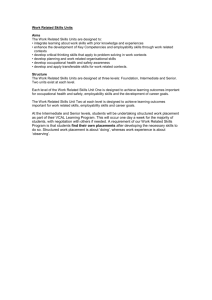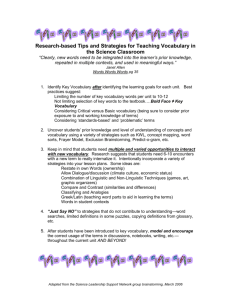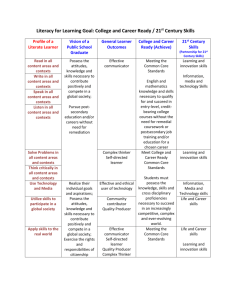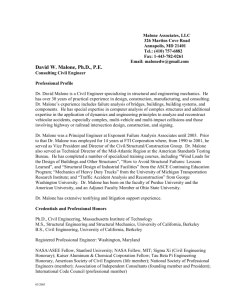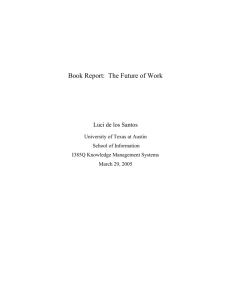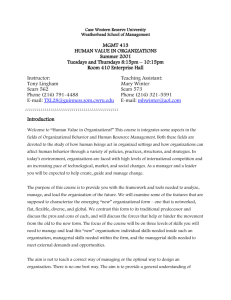Distributed Leadership From Pyramids to Networks
advertisement
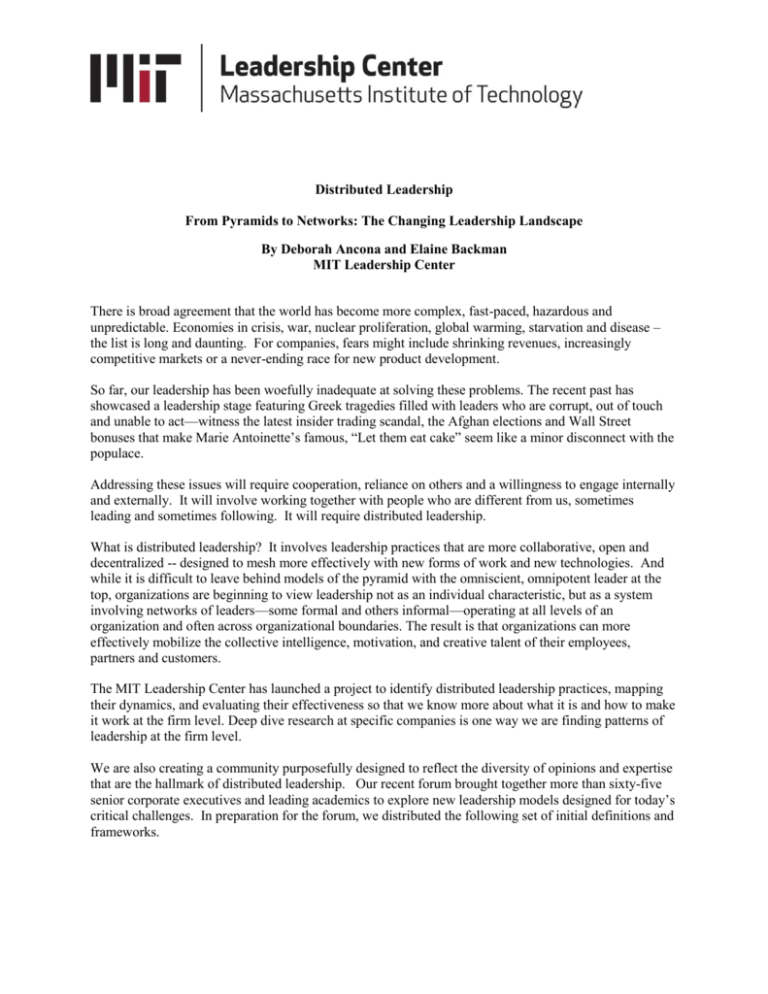
Distributed Leadership From Pyramids to Networks: The Changing Leadership Landscape By Deborah Ancona and Elaine Backman MIT Leadership Center There is broad agreement that the world has become more complex, fast-paced, hazardous and unpredictable. Economies in crisis, war, nuclear proliferation, global warming, starvation and disease – the list is long and daunting. For companies, fears might include shrinking revenues, increasingly competitive markets or a never-ending race for new product development. So far, our leadership has been woefully inadequate at solving these problems. The recent past has showcased a leadership stage featuring Greek tragedies filled with leaders who are corrupt, out of touch and unable to act—witness the latest insider trading scandal, the Afghan elections and Wall Street bonuses that make Marie Antoinette’s famous, “Let them eat cake” seem like a minor disconnect with the populace. Addressing these issues will require cooperation, reliance on others and a willingness to engage internally and externally. It will involve working together with people who are different from us, sometimes leading and sometimes following. It will require distributed leadership. What is distributed leadership? It involves leadership practices that are more collaborative, open and decentralized -- designed to mesh more effectively with new forms of work and new technologies. And while it is difficult to leave behind models of the pyramid with the omniscient, omnipotent leader at the top, organizations are beginning to view leadership not as an individual characteristic, but as a system involving networks of leaders—some formal and others informal—operating at all levels of an organization and often across organizational boundaries. The result is that organizations can more effectively mobilize the collective intelligence, motivation, and creative talent of their employees, partners and customers. The MIT Leadership Center has launched a project to identify distributed leadership practices, mapping their dynamics, and evaluating their effectiveness so that we know more about what it is and how to make it work at the firm level. Deep dive research at specific companies is one way we are finding patterns of leadership at the firm level. We are also creating a community purposefully designed to reflect the diversity of opinions and expertise that are the hallmark of distributed leadership. Our recent forum brought together more than sixty-five senior corporate executives and leading academics to explore new leadership models designed for today’s critical challenges. In preparation for the forum, we distributed the following set of initial definitions and frameworks. Definitions Leadership: Taking responsibility to engage with others to identify and achieve shared purpose in the face of uncertainty (Ganz, 2009). This definition assumes that leadership is a social process that produces contextual awareness (sensemaking), direction (visioning), commitment (relating), and aligned action (inventing) (Ancona, Malone, Orlikowski, Senge 2007). For the purpose of the forum discussions, we distinguished between two “ideal types” of leadership: Command and Control Leadership: leadership exercised individually by those in formal positions of authority in a clearly defined hierarchy. Distributed Leadership: leadership exercised by multiple leaders throughout the organization -- some in formal positions of authority and some not --working collaboratively across organizational levels and boundaries. Framework 1: Organizational Contexts Experimentation with distributed leadership is occurring in different organizational contexts. These settings are like petri dishes, each offering different contexts in which experimentation is occurring and each in turn affecting which practices arise and which ones succeed. We have identified four such organizational contexts: Traditional Hierarchies like IBM, Cisco, and Best Buy that are trying to introduce distributed practices as an overlay on a traditional hierarchy. This category also includes professional organizations, which may have fewer levels and be governed by a partnership model, but are nonetheless trying to shift from their top-down, centralized control to distributed leadership. Distributed DNA (Flat) Organizations like Google, W.L. Gore and Whole Foods that have minimized hierarchy and maximized collaboration with multi-directional influence from their inception. Nimble Networks such as Wikipedia, open source projects, and Proctor and Gamble’s “Connect and Develop” initiative that are composed of individuals or networks working semi-autonomously that may never take on a formal organizational form but nevertheless produce complex outputs. Cross-Organizational Collaborations such as joint ventures in Silicon Valley or value chain collaborations including corporations, NGOs, and local suppliers that partner across sectors to provide predictable raw material delivery and sustainable work practices. Figure 1 provides graphic representations of the four organizational contexts. In understanding distributed leadership practices it is important to identify the context in which it occurs, and what can be learned both within each organizational context and across them. FIGURE 1 Framework 2: Common Elements of Distributed Leadership Systems While many organizations are experimenting with selected distributed leadership practices, some have woven together multiple practices into broader distributed leadership systems. Our early case studies have identified five common elements that seem to characterize these systems: 1. Spontaneous Forms of Collaboration. While organizations that rely on command and control leadership and those that rely on distributed leadership may both exhibit significant levels of collaboration, the latter appear to involve more fluid and spontaneous forms. For example, when there was a technical glitch at the interface of work done by three groups at a company with command and control leadership, the organization arranged for a meeting of the three group managers to discuss the problem and decide how to proceed. In an organization with distributed leadership facing a similar problem, members from each of the groups “swarmed” together when the glitch was identified, did a quick diagnosis, brainstormed solutions, and immediately sent a small group out to a local supplier to find a part to fix the problem. 2. Multi-directional Influence. In one company moving toward a more distributed form of leadership the senior manager stopped making the choices about which new product ideas would move forward. Instead she created a cross-organizational committee, gave them a budget, and told them to choose which projects to fund. These decisions then prompted new, on-going dialogue between the committee and the manager about funding levels and strategic direction. We saw similar multi-directional influence in organizations that relied more fully on distributed leadership practices. In one organization key decisions are even made by external partners. 3. Local Entrepreneurship. Several companies with strong distributed leadership we studied offered many examples of employee-initiated change. At one high-tech manufacturing company, for instance, many new product ideas were hatched by engineers in their “doodle time”. Many of these engineers were then able to attract sufficient interest and commitment from coworkers, get funding, and actually create new businesses for their firm. 4. Global Purpose. In organizations with command and control leadership, the top of the organization sets strategy and others implement their specific part. In organizations with distributed leadership, however, there appears to be more widespread and in-depth understanding of the shared purpose and vision of the organization. In one organization we visited everyone from the top of the organization to low-level technicians could talk about the organizational vision—as well as the markets they served, the financial return they needed, and the resources they could use. People did not have a sense of their job in isolation, but rather held a sense of the whole. In addition, people felt that they had freedom to act in new ways to contribute to the global purpose and even shape it. 5. Peer Mitigation of Risk. In organizations with high levels of distributed leadership there was clear evidence of shared accountability for organizational survival and mitigation of risk. While organizations practicing command and control leadership often have specialized risk assessment groups and risk limitation rules, more distributed forms seem to augment these mechanisms with shared cultural norms supporting smaller bets on a broader array of new products and markets. People throughout the organization regulate themselves and check on others to be sure that no one is putting the whole organization in jeopardy. While our research is still in its early stages and this list will likely evolve, it is clear that in systems of distributed leadership many more individuals take on the role of leader—whether they have formal positions of authority or not. These leaders engage proactively and collaboratively to create change, rather than waiting for direction from above. And they do so not chaotically but in alignment with the shared global purpose that focuses and guides action and with mutual regulation to avoid excess risk. Framework 3: Identifying Different Levels and Patterns of Distributed Leadership While many organizations have introduced distributed leadership practices, there is a great deal of variations across organizations in the overall level and patterns of distributed leadership. In order to begin the process of understanding these variations, we need to develop ways to map and measure distributed leadership, First, we can look at the leadership behaviors of employees. We can document the proportion of employees engaged in leadership activities: creating contextual understanding (sensemaking) setting direction (visioning), gaining commitment (relating), and aligning action (inventing). We can then create diagrams of how these leaders are distributed across formal and informal roles and across different levels of the organization. If all of the leadership behaviors are concentrated in a small number of leaders at the top then there is no distributed leadership. Second, the elements of distributed leadership systems can be measured to see how many of them are present. One might argue that in the financial services sector there were many attributes of distributed leadership. However, missing were the peer risk mitigation mechanisms that might have avoided the financial crisis. Similarly, organizations can have high levels of spontaneous collaboration but still follow more of a command and control influence pattern. We can begin to map how many elements are present, and how different patterns are related to performance. Third, distributed leadership can be confined within different boundaries. In one organization there is an attempt to begin the practice of distributed leadership but thus far the efforts have only spread to the top three levels of the firm. Another organization is particularly effective at practicing distributed leadership within the firm, but employees have difficulty exhibiting the same practices when dealing with other firms. Thus, one way to map patterns of distributed leadership (both the behaviors of individual leaders and the elements of the organization) is to indicate which elements of distributed leadership are being practiced across which boundaries. The research on distributed leadership is still in its infancy. Hopefully, however, these definitions and frameworks will help to begin the process of understanding this new form of leadership that we believe to be so relevant and pivotal at this moment in time. Suggested Readings Achtenhagen, L., Melin, L., Mullern, T., and Ericson, T. 2003. Leadership: The role of interactive strategizing. In A. Pettigrew, R. Whittington, L. Melin, C. Sanchez-Runde, F. Van Den Bosch, W. Ruigrok and T. Numagami (eds.), Innovative forms of organizing: International perspectives: (49-71). London: Sage Publications. Ancona, D., Malone, T. W., Orlikowski, W. J., Senge, P. M. 2007. In praise of the incomplete leader. Harvard Business Review, 85(2): 92-100. Ganz, M. 2009. Distributed Leadership in the Obama Campaign. http://mitworld.mit.edu/662. Gronn, P. 2002. Distributed leadership as a unit of analysis. Leadership Quarterly, 13(4): 423-451. Maccoby, M. and Heckscher, C. 2006. A note on leadership for collaborative communities. In C. Heckscher and P. Adler (eds.) The firm as a collaborative community, 469-478. New York: Oxford University Press. Malone, T. W. 2004. The future of work: How the new order of business will change your organization, your management style, and your life. Cambridge, MA: Harvard Business School Press. McCauley, C. D., Palus, C. J., Drath, W. H., Hughes, R. L., McGuire, J. B., O’Connor, P. M., Van Velsor, E. 2008. Interdependent leadership in organizations: Evidence from six case studies. Greensboro, NC: Center for Creative Leadership. Pearce, C.L., & Conger, J.A. 2003. Shared leadership: Reframing the hows and whys of leadership. Thousand Oaks, CA: Sage Publications. Useem, M. and Harder, J. 2000. Leading laterally in company outsourcing. Sloan Management Review Winter 2000: 25-36. Uhl-Bien, M., Marion, R., McKelvey, B. 2007. Complexity leadership theory. Shifting from the industrial age to the knowledge era. Leadership Quarterly 18(4): 298-318.





